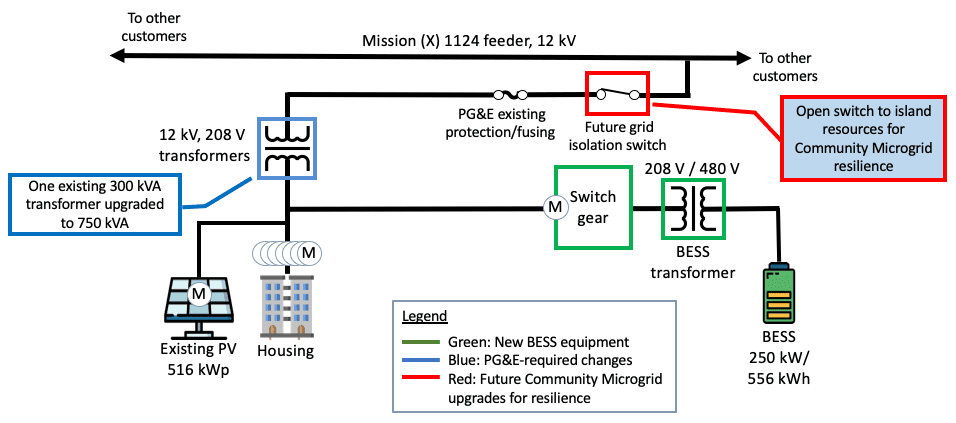
Front-of-meter (FOM) energy storage interconnection needs serious policy innovation
Lessons on fixing FOM interconnection from the Valencia Gardens Energy Storage (VGES) case study.
In partnership with the California Energy Commission (CEC) and Pacific Gas & Electric (PG&E), the Clean Coalition is leading the Valencia Gardens Energy Storage (VGES) Project, which is staging to become the first front-of-meter (FOM) merchant energy storage project in California. The project is sited at the Valencia Gardens Apartments, a complex that houses hundreds of low-income families and senior citizens in the heart of San Francisco.
Because there is 516 kW of FOM solar already sited atop the Valencia Gardens Apartments and interconnected to a distribution feeder that hosts a total of 580 kW of solar and that supports a peak load of 570 kW, the feeder has no additional solar hosting capacity. In order to significantly enhance the solar hosting capacity of this feeder, VGES was scoped to add 548 kW and 1,096 kWh of energy storage that is configured to absorb solar generation and shift it into the grid’s critical peak loads, which occur in the 4-11pm timeframes in California nowadays. Due to the exorbitantly costly and extreme uncertainty associated with FOM interconnections, however, the original Small Generator Interconnection Agreement (SGIA) that had been executed for VGES had to be terminated.
Unfortunately, this failed FOM interconnection is the rule rather than the exception for FOM distributed energy resources (DER) projects – and this situation has straightforward fixes. The Clean Coalition’s detailed case study intends to educate all key parties, particularly policymakers, about the immense barriers and easy solutions associated with FOM interconnection. As such, the case study has been submitted to the CEC and into multiple proceedings at the California Public Utilities Commission (CPUC); this article summarizes key points.
Read the full FOM energy storage interconnection case study here
Project benefits
By demonstrating how targeted deployment of energy storage can increase the grid’s ability to handle greater amounts of local solar, yielding substantial grid and ratepayer benefits, VGES will set the stage for increased deployment of clean local energy in California and beyond.
Specific project benefits include:
- Enhancing the solar hosting capacity of the existing feeder by more than 25%.
- Quantifying the value of grid services from FOM energy storage to the PG&E distribution grid and to the CAISO-jurisdictional transmission grid.
- Investigating the technical and economic details associated with configuring FOM DER into Community Microgrids that deliver unparalleled resilience to customers, like the vulnerable populations that reside at the Valencia Gardens Apartments. Importantly, through a Valencia Gardens Community Microgrid, the hundreds of vulnerable residents can be sheltered in place rather than have to be transferred to emergency shelters during disasters, where they would just consume space and other resources that should be reserved for people who cannot be easily sheltered in place.

Key challenges
To date, the VGES Project has experienced multiple challenges that have been detrimental to its progress:
- Time: It took two years from the inception of the Fast Track Interconnection process to completion of the pre-construction phase, when permits could be pulled.
- Cost: The cumulative costs increased throughout this time period, growing from the expected $156,999 to $460,887.
- Uncertainty: Uncertainties around PG&E personnel, equipment upgrades, construction requirements, costing, project schedule, and timelines prevented the project from moving forward as expected.
The following images compare the expected process to the actual experience for the VGES FOM Fast Track Interconnection process from December 2017 (Interconnection Application submittal) to December 2019 (okay to pull permits).
Expected VGES Fast Track Interconnection process:
~ 6 months and final cost in range of $75k – $100k
Actual VGES Fast Track Interconnection process:
25 months and final cost near $461k
Proposed solutions
The Clean Coalition is proposing two key solutions to streamline FOM interconnection: a Pilot for Streamlining Fast Track FOM Energy Storage Interconnection and a Fixed Fee & Utility Pays (FixUP) policy.
Pilot for Streamlining Fast Track FOM Energy Storage Interconnection
The proposed pilot will shorten the interconnection application review process and pre-construction timelines while decreasing costs and design review inefficiencies. The enhanced interconnection process will allow early discovery and resolution of upgrade and design-based issues, which should reduce the time to pull permits from over two years to just under six months as well as allowing the applicant time to find cost-effective solutions to issues that utilities will inevitably present.
Core pilot components:
- A more complete application package to be submitted by the interconnection applicant, ready for detailed analysis.
- Scoping review merged into technical analysis and mandatory field meeting, allowing for early exploration of alternative solutions to PG&E discretionary thresholds and early resolution of any issues discovered.
- Final design and costing locked in early, with the financial burden placed on PG&E for cost and/or design changes made after the technical analysis and mandated field meeting.
- Reduced costs for interconnection facilities upgrades and design changes.
- Shortened timeline gap between SGIA / financial security deposit phase to pre-construction / permit-ready status.
Moving forward, VGES is pursuing a new FOM interconnection with a battery that is half the original size in order to avoid the numerous issues that were presented more than a year after the original SGIA was fully executed. Alarmingly, the shrinking battery size, which of course reduces any grid impacts, required the original SGIA to be terminated. In any case, PG&E made it clear that its biggest barriers, the requirement for an underground vault and a new recloser, would be eliminated by halving the battery size. The only silver lining of the situation is that the proposed Pilot for Streamlining Fast Track FOM Energy Storage interconnection can be applied to the new battery (“1-BESS”) FOM interconnection process for a clear comparison to the original battery (“2-BESS”), as follows:


For the full proposed pilot, see Appendix A of the case study.
Fixed Fee & Utility Pays (FixUP) policy
Current project economics, as well as uncertainties, make FOM interconnection costs prohibitive. As the single most important policy innovation to streamline FOM interconnection, the Clean Coalition proposes the FixUP policy to extend the streamlined behind-the-meter (BTM) interconnection processes, timing, and price certainty to small FOM projects.
FixUP will allow FOM projects to determine whether they qualify for Fixed Fee interconnection based on publicly accessible eligibility criteria. All FOM projects that are no larger than 1 MW will avoid the bureaucratically complex and unnecessary process of having to pay for grid upgrades and then legally deed those upgrades to the utility, as well as eliminating the need for an escrow account.
The Clean Coalition estimates that FixUP will yield an average of at least $25,000 in bureaucratic savings alone per FOM project. The Fixed Fee amount, initially estimated at $10,000, will be set at a revenue-neutral level, based on average actual costs incurred by the utility. For FOM projects that are no larger than 1 MW and that do not meet all of the other Fixed Fee eligibility criteria, the utility will still directly pay for any interconnection costs to streamline the interconnection process for these small FOM projects and then recover those costs based on standardized unit costs, which each utility already publishes annually.
| Description | Fees |
| Pre-application report | $600 |
| Application submittal / Scoping meeting (Fast Track and standardized interconnection fee approval) | $800 |
| Technical study / Supplemental Review | $2,500 |
| Results review meetings | $750 |
| Pre-construction meetings, final construction drawings, engineering costing, site visits for inspection, and actual interconnection | $5,350 |
| Total: | $10,000 |
For the full FixUP proposal, see Appendix D of the case study.
Read the full FOM energy storage interconnection case study here



